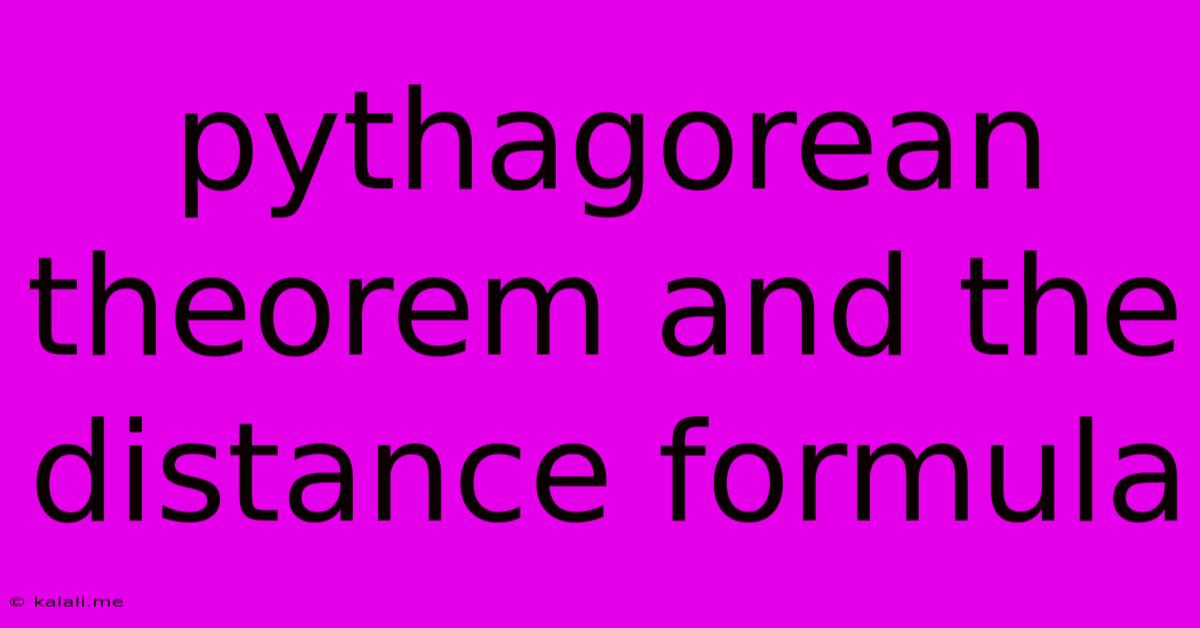Pythagorean Theorem And The Distance Formula
Kalali
May 09, 2025 · 3 min read

Table of Contents
Understanding the Pythagorean Theorem and its Application in the Distance Formula
The Pythagorean Theorem is a fundamental concept in geometry with wide-ranging applications, most notably in deriving the distance formula. This article will explore the theorem itself, its proof, and how it forms the basis for calculating distances in coordinate geometry. Understanding these concepts is crucial for various fields, including mathematics, physics, engineering, and computer science.
What is the Pythagorean Theorem?
The Pythagorean Theorem states that in a right-angled triangle, the square of the hypotenuse (the side opposite the right angle) is equal to the sum of the squares of the other two sides (called legs or cathetus). Mathematically, it's expressed as:
a² + b² = c²
where:
- a and b are the lengths of the legs of the right-angled triangle.
- c is the length of the hypotenuse.
Proof of the Pythagorean Theorem:
Several elegant proofs exist for the Pythagorean Theorem. One common visual proof involves rearranging squares built on the sides of a right-angled triangle to demonstrate the equality. Another uses similar triangles and the properties of their ratios. While a detailed exploration of each proof is beyond the scope of this article, understanding the theorem's validity is key to applying it.
Applications of the Pythagorean Theorem: Real-world Examples
The Pythagorean Theorem's practical applications are numerous. For instance:
- Construction and Surveying: Determining the distance between two points that aren't directly measurable. Imagine needing to find the length of a diagonal across a rectangular field.
- Navigation: Calculating the shortest distance between two points on a map, especially when considering obstacles or different terrains.
- Engineering: Designing structures, calculating the length of support beams, and ensuring structural integrity.
- Computer Graphics: Calculating distances between points on a screen or in 3D models.
The Distance Formula: A Direct Application of the Pythagorean Theorem
The distance formula is a direct consequence of the Pythagorean Theorem. It allows us to calculate the distance between two points in a coordinate plane (or higher dimensions). Consider two points, (x₁, y₁) and (x₂, y₂), in a two-dimensional Cartesian coordinate system.
The distance 'd' between these points can be found by imagining a right-angled triangle where the legs are the horizontal and vertical distances between the points.
The horizontal distance is |x₂ - x₁| (the absolute difference in x-coordinates). The vertical distance is |y₂ - y₁| (the absolute difference in y-coordinates).
Applying the Pythagorean Theorem, we get the distance formula:
d = √[(x₂ - x₁)² + (y₂ - y₁)²]
Extending the Distance Formula to Higher Dimensions
The distance formula can be extended to three or more dimensions. For example, in three dimensions, with points (x₁, y₁, z₁) and (x₂, y₂, z₂), the distance formula becomes:
d = √[(x₂ - x₁)² + (y₂ - y₁)² + (z₂ - z₁)²]
Conclusion: A Cornerstone of Geometry and Beyond
The Pythagorean Theorem and the distance formula are fundamental tools in mathematics and have widespread applications in various fields. Understanding their derivation and application is crucial for anyone working with geometry, spatial reasoning, or any field that requires distance calculations. From simple construction tasks to complex computer simulations, these concepts remain essential cornerstones of mathematical understanding.
Latest Posts
Latest Posts
-
What Percent Of 75 Is 90
May 09, 2025
-
What Is 2 To The 8 Power
May 09, 2025
-
What Percentage Of 18 Is 6
May 09, 2025
-
What Does The Arrow Represent In A Food Chain
May 09, 2025
-
How Do You Know A Chemical Reaction Has Taken Place
May 09, 2025
Related Post
Thank you for visiting our website which covers about Pythagorean Theorem And The Distance Formula . We hope the information provided has been useful to you. Feel free to contact us if you have any questions or need further assistance. See you next time and don't miss to bookmark.